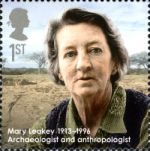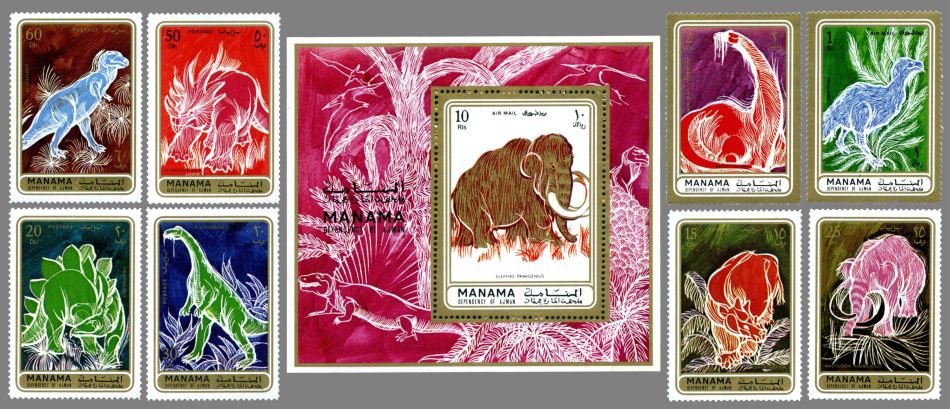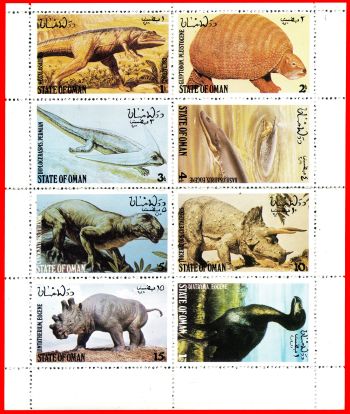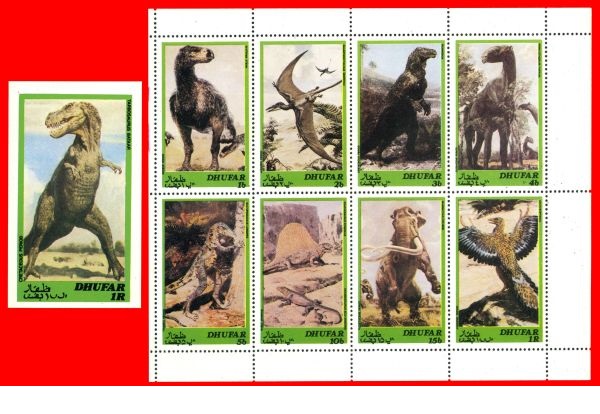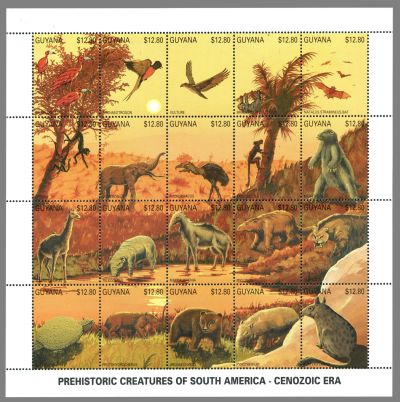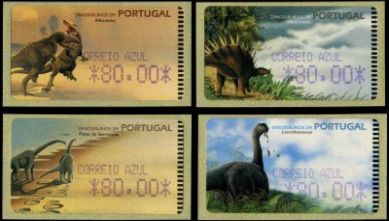the place where Paleontology and Paleoanthropology meets Philately
Milestones of Paleontology and Paleoanthropology related Philatelic items.
Paleophilatelie (Paleophilately) is branch of Philately dedicated to collection of Philatelic items related to Paleontology and Paleoanthropology.
"Paleontology, also spelled Palaeontology, scientific study of life of the geologic past that involves the analysis of plant and animal fossils, including those of microscopic size, preserved in rocks. It is concerned with all aspects of the biology of ancient life forms: their shape and structure, evolutionary patterns, taxonomic relationships with each other and with modern living species, geographic distribution, and interrelationships with the environment. Paleontology is mutually interdependent with stratigraphy and historical geology because fossils constitute a major means by which sedimentary strata are identified and correlated with one another. Its methods of investigation include that of biometry (statistical analysis applied to biology), which is designed to provide a description of the forms of organisms statistically and the expression of taxonomic relationships quantitatively."
“Paleoanthropology, also spelled Palaeoanthropology, also called Human Paleontology, interdisciplinary branch of anthropology concerned with the origins and development of early humans. Fossils are assessed by the techniques of physical anthropology, comparative anatomy, and the theory of evolution."
Do you know when and which country issued the first dinosaur stamp ?
Do you know who was the first paleontologist honored on a stamp ?
These, and other interesting facts can be found throughout this article.
The first stamps issued in the mid-19th century have boring designs. They were rectangular or square in shape, depicting the leader of the country: king, queen, president, or had just a face value. Even though people around the world began collecting stamps almost immediately. The first philatelists tried to find production differences between stamps of the same design—color or paper variations, difference in perforation, some errors on images, etc.
It took over 30 years until the first commemorative stamp was issued. In 1871, Peru issued a stamp showing a locomotive. Shortly after, many other postal authorities began issuing stamps dedicated to important events, local and worldwide famous places, landscapes, famous persons of the county, etc. Nowadays postage stamps are not only evidence of postal payment, but also ambassadors of the country. They tell us a story of the issuing country, shows us famous persons, landscapes and scenic sights, cultural and sporting events, and local flora and fauna.
The fossilized remains of prehistoric animals, especially large ones, such as dinosaurs or giant mammals, have always stirred the imagination of people, creating all sorts of myths and legends about Dragons, Cyclops, and ancient Giants. The well-preserved remains of the ancient inhabitants of the earth have very great scientific and material value. Some of them even have the status of national treasure.
Here is the list of Paleontology and Paleoanthropology related Philatelic milestones:
| 1922
USA, First postal stationery with prehistoric animals
This is, very likely, the very first philatelic item related to Paleontology.  The postl stationery from collection of Dr. Jon Noad from Calgary Canada 2c prepaid envelope from the USA, produced by the Torrance Lime & Fertiliser Company, from Lomita city in California, which shows some prehistoric animals and Neanderthals. [The next Paleontology related post stationery issued in Poland almost 50 years after, with fossil of ammonite on imprinted stamp.] The image on the cover based on several earlier illustrations and reconstructions: 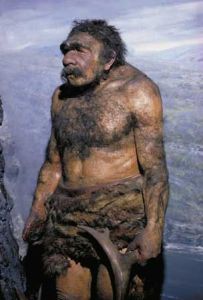
 Neanderthal man as imagined in Chicago's Field Museum diorama circa 1920. Drawing by Robert Bruce HORSFALL for “A History of Land Mammals in the Western Hemisphere“, by Robert BERRYMAN Scoot, 1913, shows a saber-toothed cat (Smilodon californicus) and a dire wolf (Canis dirus) fighting over a Columbian mammoth (Mammuthus columbi) carcass in the La Brea Tar Pits. The La Brea tar pits is very famous because of the huge range of fossils, especially of predators like Smilodon. By the way, Sabre tooth cat (Smilodon) is the heraldic animal of California and it designated as the official state fossil in 1973. 
 There is also a tetrapod dinosaur in the background, who lived much earlier as Smilodon and Neanderthal, and some marine
shells on the foreground and as also part of the logo of the companyy.
There is also a tetrapod dinosaur in the background, who lived much earlier as Smilodon and Neanderthal, and some marine
shells on the foreground and as also part of the logo of the companyy.The company used fossils of prehistoric animals to make their fertilizer. [A fertilizer is any material of natural or synthetic origin (other than liming materials) that is applied to soils or to plant tissues to supply one or more plant nutrients essential to the growth of plants.] Very strange use of fossils in today's point of view.  P.S. Many thanks to fellow collectors Peter Brandhuber from Germany and John Noad from Canada for their help finding information about the post stationery and some scans from their collections. 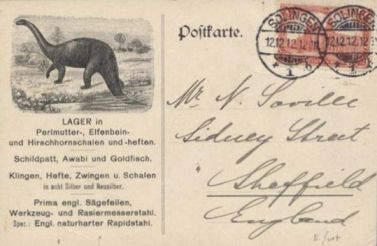 The
only earlier item that can be consider is a post card from Germany
(Postcards without imprinted stamps are not subject of philately, but
Deltiology). The
only earlier item that can be consider is a post card from Germany
(Postcards without imprinted stamps are not subject of philately, but
Deltiology).Dinosaur, perhaps Plateosaurus, shown on its illustration and some Ad text underneath. The issue date of the postcard from Germany is unknown, sent in 1912 from Solingen. Plateosaurus lived during the Late Triassic period, around 214 to 204 million years ago, in what is now Central and Northern Europe. Discovered in 1834 by Johann Friedrich Engelhardt and described three years later by Hermann von Meyer, Plateosaurus was the fifth named dinosaur genus that is still considered valid. Although it had been described before Richard Owen formally named Dinosauria in 1842, it was not one of the three genera used by Owen to define the group, because at the time, it was poorly known and difficult to identify as a dinosaur. It is now among the dinosaurs best known to science: over 100 skeletons have been found, some of them nearly complete. The abundance of its fossils in Swabia, Germany, has led to the nickname Schwäbischer Lindwurm (Swabian lindworm). More info is on Wikipedia. |
||||||
|
193x USA, First meter franking with dinosaur
This Brown's expedition was big success. More than 20 skeletons and 4.000 bones excavate there. One of the unearthed dinosaurs was Diplodocus - another long neck dinosaur, who had similar shape as Brontosaurus, but smaller in size. This Brontosaurus of Sinclair Oil is commonly known as DINO. A life-size DINO appeared in the “Century of Progress” Chicago World’s Fair in 1933-1934, along with several other dinosaurs built by P.G. Alen, who was known for creating lifelike papier-mâché animals for motion pictures. Following the Chicago World’s Fair, in 1935 the company began published dinosaur stamps like labels – and a stamp album that could be filled only with colored dinosaur "stamps" issued one at a time weekly at Sinclair service stations. This kind of "stamps" known as Cinderella in philatelic community and are the first Cinderella set of stamps depicting prehistoric animals ever. These were intended for children. In each program when you went to a Sinclair station on week one you would be given a stamp album. Then on each 8 following week you would be given a new sheetlet of stamps. The books had some advertising material but mostly contained scientific and historical information to explain the dinosaurs and petroleum to children. |
||||||
|
1946 USA, First FDCs (First Day Cover) with a dinosaur and prehistoric animal illustration On 10.08.1946, the U.S. Post Office Department issued a stamp to
celebrate the centenary (100 anniversary) of the Smithsonian Institution.
|
||||||
|
1947, 1951 USSR, First Paleontologist on stamps Sometimes it is difficult to identify paleontologists on stamps, because they are shown on neutral background, or just a portrait. On other side, not every personality shown on stamps with fossil or prehistoric animal on the background is paleontologist. 

The first stamp (known to me) shows
a paleontologist
has been issued in USSR on January 17, 1947.
Actually it is a set of two stamps
30 kopejka(100 kopejka = 1
rubel), green and 50 kopejka sepia. These stamps are show a
portrait of
A.P.
Karpinskij (1847-1936), who is most known as First
elected president of Russian
Science Academic. However, he was also great geologist and
paleontologist, who made some important discovers at Ural mountains
area of Russia. On 3 March 1952, Soviet Union issues a stamp titled "Greatest Russian scientist biologist-paleontologist: W.O. Kovalevskij" with a face value of 40 kopejka and this is actually the first stamp dedicated to paleontologist. Vladimir Onufreivich Kowalewskij (1784-1856) Russian paleontologist and supporter of Darwinism. He was the one who assumed horses are appeared first in Europe continent then migrate to North America, then come back to Europe. Evidence of this theorie found more then 100 years after his suicide due to some trouble in private and commercial life in Grube Messel by Darmstadt, Germany. Very little prehistoric horse in size of a big dog was found there and depicting on stamp of BRD in 1978.
Another category of persons to mention is "Contributors to Paleontological science" People have found fossils since ancient times, but Paleontology as a
science was established in the middle of the 19th century. The
establishment was impossible without the help of scientists from many other
sciences such as biology, botany, and geology. Many politicians and
wealthy persons supported the young
science. The fact that evolution occurs became accepted by the scientific
community and much of the general public in his lifetime, while his
theory of natural selection came to be widely seen as the primary
explanation of the process of evolution in the 1930s, and now forms the
basis of modern evolutionary theory. In modified form, Darwin's
scientific discovery is the unifying theory of the life sciences,
providing logical explanation for the diversity of life. In
recognition of Darwin's pre-eminence, he was one of only five
19th-century UK non-royal personages to be honoured by a state funeral,
and was buried in Westminster Abbey, close to John Herschel and Isaac
Newton. Darwin's work had far-reaching impacts on the development of
Paleontology, Antropology and many other Biology and Psyology related scients.
Prince Albert I of Monaco, who had a keen interest in the origins of man and who founded the Institute for Human Paleontology in Paris that was responsible for a number of archeological digs, depicting on many stamps of Monaco and some international posts, start on 1891 when his portrait appears on definitive stamps. |
||||||
|
1949 Monaco, First stamp with cave painting, first stamp with paleontologic museum, first stamp with anthropologic museum
|
||||||
|
1951 India, First reconstruction of a prehistoric animal on stamp 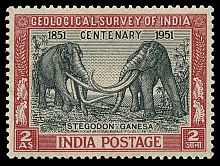 To commemorate
the Indian Geological Survey centenary on 13 January 1951,
India Post released a stamp showing two prehistoric “elephants”
(Stegodon ganesa), the first ever reconstruction of a prehistoric
animal on a stamp.
To commemorate
the Indian Geological Survey centenary on 13 January 1951,
India Post released a stamp showing two prehistoric “elephants”
(Stegodon ganesa), the first ever reconstruction of a prehistoric
animal on a stamp. Stegodons were primarily an Asiatic group of Mammutidae. This family is believed to have evolved sometime by the middle Miocene, nearly 15 million years ago, and became extinct by the late Pleistocene about 30,000–40,000 years ago. Stegodons appear to be transitional between true mastodons on the one hand and true elephants on the other. In 1928, a three-meter long fossil tusk of an elephantine mammal (Stegodon ganesa) was discovered by Dr. Darashaw Nosherwan Wadia (1883–1969) who pursued his personal research on stratigraphy, structure, and paleontology of the Kashmir Himalayan region with single-minded devotion. Being a very keen observer, he worked towards identification of broad structural elements of the northwest Himalayas. The discovery of this skull, which was found in association with fossil ganoid fish and pteridospermous plants, led to the fixing of the age of an important geological rock formation in the Kashmir Himalayas to the Permo-Carboniferous period (355–250 million years ago). The fossil tusk is now kept at the museum of the Geology Department of the Jammu University. Note: On March 4, 2001 another stamp was issued by the Department of Post, Government of India, to commemorate 150 anniversary of Indian Geological Survey, but this time geological motive has been choose, the four color stamp shows some minerals. |
||||||
|
1952 Algeria, First fossil on a stamp  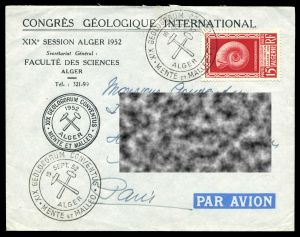 In 1952, Algeria issued the first stamp showing a fossil.
In 1952, Algeria issued the first stamp showing a fossil. In that year, the XIX International Geological Congress was held in Algeria. The host country issued two special stamps on August 11th to promote this event. The ammonite fossil depicting on the 15-franc stamp is Berbericeras sikikensis. Ammonites are excellent index fossils, and it is often possible to link the rock layer in which they are found to specific geological time periods. Therefore, they appear on several philatelic items related to some geological events. The second stamp, denominated 30fr, shows one of the most famous geological sites in the country—the Hoggar Mountains. . |
||||||
|
1955 USA First stamp with a bones, skeleton of prehistoric animal 
The stamp pictures Charles Wilson Peale’s self-portrait, “The Artist in His Museum” (see on the right, the image is from
Wikipedia)
Many of the museum’s exhibits were collected by Peale, and he includes some of them in his painting. The stamp features several, like a wild
turkey ready to be preserved as well as a great mastodon bone, in honor of one of Peale's greatest reconstruction of a mastodon’s skeleton. |
||||||
|
1958 China, First stamp of Dinosaur 
On 15 April 1958, the People’s Republic of China issued a set of three stamps titled, “Chinese
Paleontology.” |
||||||
|
1961 Switzerland, First fish and plant fossil on stamp 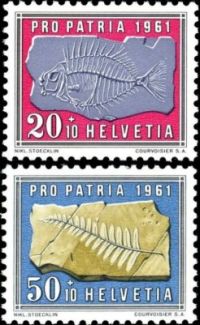

Between 1958 and 1961 Swiss Post, in cooperation with
Pro Patria organization, issued four semi-postal stamp sets showing
some fossils and minerals from the collections of local museums. Pro Patria is a Swiss patriotic
and charitable organization. Its
purpose is to give meaning to the Swiss national holiday, 1 August, by
collecting donations to benefit social and cultural works of national
public interest.
One of the methods the organization uses to collect donations is the issue of semi-postal stamps. The first stamp set was issued in 1938. All sets contain five stamps: one
stamp with a logo of the
Pro Patria campaign and four stamps showing minerals and fossils. The
additional amount paid for each sold stamp
transferred to the organization. Actually, these are the first
semi-postal stamps with a paleontological context ever
issued. |
||||||
|
1965 Poland, First pictorial stamp sets depicting prehistoric animals 
The designs are based on pictures by Zdenek Burian, a
Czech painter and book illustrator, In the following year Poland issues another stamps set with prehistoric animals from fish till mammoth that supposed to show animal evolution. The first stamps set dedicated to prehistoric mammals issued in the same year in Romania that shows reconstruction of the animals and their skeletons. The next stamps set of prehistoric mammals issued 5 years later only in Bulgaria. |
||||||
|
1965 Tanzania, Fist stamp of human fossil 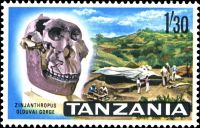
Also in 1965,
the first stamp
with an early human fossil came from Tanzania,
the “cradle of humankind.” On 9 December, Tanzania issued a set of 14 definitive
stamps with some typical animals, landscapes, and some
historical episodes to show development of the country. For much of her career, Mary Leakey
(1913–1996) worked together with her husband, Louis Leakey (1903–1972),
in Olduvai Gorge, uncovering the tools and fossils of ancient hominids.
She developed a system for classifying the stone tools found at
Olduvai. She also discovered the Laetoli footprints. It was
there, at the Laetoli site, that she discovered hominid fossils that
were more than 3.75 million-years-old. In addition, she discovered 15
new species of other animals, and one new genus. |
||||||
|
1967 Cuba, First pictorial stamps set of prehistoric human 
On 31 March 1967, Post
Authority of Cuba issued a set of seven stamps that were the first to
show human evolution. Each stamp shows a skull stage of the human
relevant and depicts major stage of human development
known from worldwide fossil record. |
||||||
|
1970 Lesotho First stamps with footprint of prehistoric animals 
On 5 January 1970, Lesotho issued a set of five stamps showing some footprints of dinosaurs and other prehistoric animals. "Dinosaurs and footprints at Moyeni" (1st serie, the 2nd serie issued in 1984 and shows footprint of another three dinosaurs). Fossilized footprints of dinosaurs and other prehistoric reptiles, dated of about 200 MYA (upper Triassic period), found at Moyeni in the Quthig district of Lesotho. Four of five stamps shows not only the footprint but also reconstruction of the animals moved at sand and sea shore. Paleoichnology
is the study of fossilized footprints. Scientists can learn
many things from such tracks. They can give an idea about
size of the animal and if it walked on two or four legs. |
||||||
|
1970 Poland, First post stationary with imprinted fossil stamp 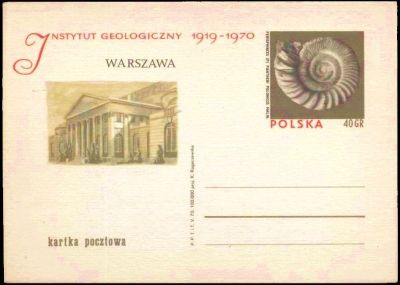
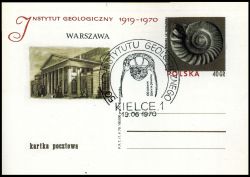
On June 19th, 1970 Polish Postal Service issued a post card to commemorate the 50th anniversary of the Polish Geological institute (face value 40gr., quantity 100.000). The building of the institute depicting on the left side of the card. The imprinted stamp shows an ammonite of genus Perisphinctes, from collection of the institute. The ammonite is about 30cm in size and can be founded in various location in Poland. A trilobite of genus Marrolithus ornatus featured on a special post mark issued in Kielce. This blind trilobite is only 2 cm in size, probably borrowed in the mud of Ordovician sea floor(485-443 MYA). |
||||||
|
1970 Angola, First Paleontology related stamps at diamond shape 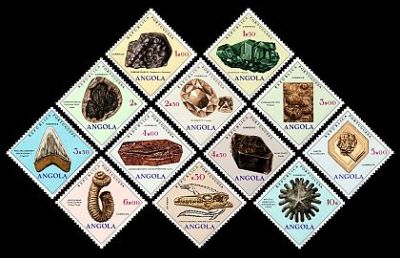
Most stamps issued around the world have been rectangular or square shape.
However, from time to time some post authorities produce stamps with other shapes. On October 31 1970, Angola issued a set of definitive stamps with title "Geology, Mineralogy, Paleontology" shows some minerals and fossils found in the country. All 12 stamps of the set have diamond shape. The six stamps that belong to Paleontology are: 0$50, Angolasaurus, skull and reconstruction, 2$00, Gondwanidium validum, 3$00, Stromatolites, 3$50, Procarcharodon megalodon tooth, 4$00, Microceratodus angolensis fossil, 6$00, Nostoceras helicinum, 10$00, Rotula orbiculus angolensis. Angolasaurus
is an extinct genus of plioplatecarpine mosasaur. Definite
remains from this genus have been recovered from the Turonian of Angola
and some other places around the world. First named in 1964 by Miguel
Telles Antunes on the basis of a partial skull and skeleton, exactly as
depicting on the stamp. |
||||||
|
1971 Manama, First Souvenir/Miniature sheet of prehistoric animal
Souvenir-Sheet is a small sheet containing one or more stamps with wide margins,
usually with illustration or inscription.
The first Souvenir-Sheet was issued by the Post of Luxembourg in 1923. The set contains eight stamps showing various prehistoric animals, mostly dinosaurs, and a miniature sheet with a mammoth on a 10-riyal stamp along with some other prehistoric animals on the margin. The animal depicting on the stamp is a wooly mammoth (Elephas primigenius), a species that lived during the Pleistocene epoch from 2.588 million years ago (MYA) to 11,700 years ago, and was one of the last in the line of mammoth species. From the 1960s until the end of the
1980s, some small Middle Eastern countries (called “Sand Dunes” by
philatelists) produced stamps in huge quantities for every popular
topic: space, sports, famous people, etc. These stamps were aimed at
stamp collectors rather than postal use and usually were never
available in the country of origin to actually use on letters as
postage. One such set is from Fujeira
(1968). |
||||||
|
1980 State of Oman and, Dhufar, First unofficial/ illegal issue of stamps with prehistoric animals
In
the nineteen seventies and -eighties, rebel groups attempting to
overthrow the Oman government took control over parts of the country on
the Arabian peninsula. In order to raise funds and to establish
themselves as rightful rulers, stamps were issued under the names
'State of Oman' and ' Dhufar'. |
||||||
|
1991 Guyana First stamps Sheet with prehistoric animals Traditionally stamps were printed in sheets of several similar stamps, later on
postal authorities started to produce stamp sets on sheets. Such sheets
were usually designed as a big picture composed of many different
stamps. On one hand, it is nice to have a whole picture, but on the
other hand, these occupy a large space in an album and are not useful
for non-philatelist customers.
|
||||||
|
1992 Thailand, First stamps booklet with prehistoric animals
The first booklet with official postage stamps was introduced by Luxembourg in 1895. The booklet offer a variety of opportunities for the Postal Administration's promotion messages and commercial advertisements on covers or the interleaves. Commercial advertisements appeared into stamp booklets for the first time in Germany in 1905 and in Great Britain in 1909. The first booklet with fossils was issued in Thailand on 1 January 1992. The booklet contains five mint stamps showing a dinosaur excavation and dinosaur skeletons. These stamps are part of set of four stamps dedicated to centenary of the Thai Department of Mineral Resources. The same year, on 9 September, the Swedish postal service issued a booklet with stamps of prehistoric animals consisting of two blocks of four stamps each. The booklet also contained some information about the animals. |
||||||
|
1993 Australia, First self-adhesive stamps of prehistoric animals  On 1 October 1993, three British Commonwealth countries (Australia, Canada, and New Zealand)
simultaneously issued some sets of stamps showing dinosaurs and other
prehistoric reptiles. All three sets were sold with a thematic stamp
book, The Stamp of the Dinosaur, which also told the story of
dinosaurs.
On 1 October 1993, three British Commonwealth countries (Australia, Canada, and New Zealand)
simultaneously issued some sets of stamps showing dinosaurs and other
prehistoric reptiles. All three sets were sold with a thematic stamp
book, The Stamp of the Dinosaur, which also told the story of
dinosaurs. Australian stamps issued in several formats: 6 mint stamps issued in separate sheets of 15, mini sheet of all 6 stamps. Two stamps from the Australian set were issued as self-adhesive and sold as a booklet of ten and in rolls. These first self-adhesive stamps of prehistoric animals shows the following prehistoric animals. 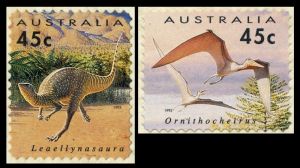 Leaellynasaura,
about the size of a chicken with a skull only 6
centimetres long, Leaellynasaura was a bipedal herbivorous dinosaur.
Its eyes were exceptionally large, as was the part of the brain
dedicated to processing visual signals (the optic lobes). It would
appear to have been adapted for life in semi-darkness. During much of
the Cretaceous, when Leaellynasaura lived, Australia was far closer to
the South Pole than it is now, and would have been almost continuously
dark for two or three months of each year. It has been suggested that
this little dinosaur, too small to migrate,remained active throughout
the long winter.
Leaellynasaura,
about the size of a chicken with a skull only 6
centimetres long, Leaellynasaura was a bipedal herbivorous dinosaur.
Its eyes were exceptionally large, as was the part of the brain
dedicated to processing visual signals (the optic lobes). It would
appear to have been adapted for life in semi-darkness. During much of
the Cretaceous, when Leaellynasaura lived, Australia was far closer to
the South Pole than it is now, and would have been almost continuously
dark for two or three months of each year. It has been suggested that
this little dinosaur, too small to migrate,remained active throughout
the long winter.
Ornithocheirus, flying reptiles or pterosaurs were not dinosaurs. However, they lived at the same time and were warm-bloodedthe energy demands of flight could never be met with a cold-blooded metabolism. Ornithocheirus lived in the Late Cretaceous and is also found in Europe, South America and Africa. During the 19th century, in England many fragmentary pterosaur fossils were found in the Cambridge Greensand. First found in Australia in 1979, near Boulia in south-western Queensland. It was a coastal species, and had a wing span of about 2.5 metres. 
|
||||||
|
1998 Singapore, First ATM stamps with prehistoric animals 

On 22 April 1998, the Singapore Post introduced the
first automatic teller machine (ATM) stamps depicting dinosaurs. The stamps shows the following dinosaurs (from left to right): The Pentucerutops ("five horned face") belongs to the family of Cerutopsidae. They looked like the rhinoceros and were plant-eaters with huge heads, bulky bodies and heavy limbs and hooike claws. The Apatosaurus
("deceptive lizard") was from the family of Diplodocidae. The
Diplodocids stood highest at the hips, earing weight upon their
elephantine limbs with short broad "hands" and feet. The Apatosaurus
were plant-eaters which existed in the Late Iurassic period, and were
very large with long whiplash tail and long neck. The Albertosuurus
("Alberta lizards") was related to the Tyrannosaurus (or T-rex)
featured in the movies. They were fierce predatory animal
that
ran fast and they would lunge with their heads to take "scoop bites"
from their victims bodies. |
||||||
1999
Portugal,
First FRAMA stamps of
prehistoric animals
Note:
Amiel machine used big and bold font, SMD printed the text in small, regular font. Some machines used black ink rather than blue one, such stamps are very difficult to get. Moreover ATM machines at philatelic desk of Portuguese Post programmed differently as ATM machines at post offices. Stamps sold to philatelist used a dot (".") as currency separator, when stamps sold at post offices used a comma (",") as currency separator, therefore mint stamps with comma separator are more difficult to get. With introduction of common European currency the ATM machines were reprogrammed to print face value in Escudo and Euro currency in 2000 and Euro only in 2002. |
||||||
|
2009 South Africa, First set with 3D stamp of prehistoric animals 
The first 3D stamp set has
been issued by South
Africa in 2009.
There are two mini-sheets 4 and 6 stamps each as well as two FDC cards. Five of the stamps depict skeletons of different types of dinosaurs, while the other five stamps show images of what scientists believe these creatures most probably looked like. All the dinosaurs depicting on the stamps have an African connection.
|
||||||
|
2010 South Korea, First stamps of prehistoric animals with odd perforation  
Traditionally perforation of stamps made of small holes evenly distributed around the stamp. Since 2000, for security reasons, some Post Authorities start use some odd forms at stamps perforation. On 05th o f August 2010, Korean Post issued the stamp set "The Age of Dinosaurs Series (1st Issue)" with perforations in the shape of dinosaur. In the following years Post of South Korea issued two more sets of dinosaurs with similar perforations (2011, 2012). On 5 March 2015, Switzerland issued a 2-swiss
franc souvenir sheet containing one irregularly shaped stamp
depicting an ammonite fossil along with an image showing a
reconstruction of how the creature may have appeared when it was living. |
||||||
|
2012 Turkey, First hologram-motion stamps depicting dinosaur 
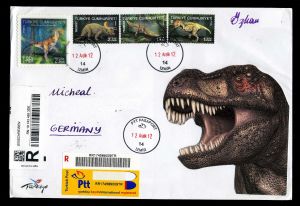
On 05th of June 2012, Post Authority of Turkey issued a stamp set "World environment day (Dinosaurs)".The set is a mini-sheet of 4 stamps. Additionally, souvenir book with one more plastic Lenticular (3d hologram-motion) stamp and several post cards are printed out. The Lenticular stamp, depict running T-Rex is the first Lenticular depicting dinosaur on it. Even though it sold with the booklet only is a valid post stamp, and can be used for postage, see on the right. |
||||||
2014 Hong Kong, First luminous stamps depicting prehistoric animals
|





 One of most notable contributors to establishment of Paleontology science in
United States was the third US President
One of most notable contributors to establishment of Paleontology science in
United States was the third US President 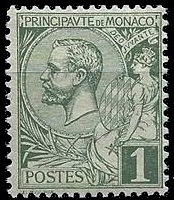 Jefferson
is rightfully renowned as the
principal author of the Declaration
of Independence, the Third President of
the United States, and a champion
of liberty. But he was also a
central player in the beginnings of
American paleontology. In addition, his
participation occurred at a time when
people were struggling with the
ideas of fossils as evidence of
past life, of extinction, and of
an Earth far older than the
Biblical account.
Jefferson
is rightfully renowned as the
principal author of the Declaration
of Independence, the Third President of
the United States, and a champion
of liberty. But he was also a
central player in the beginnings of
American paleontology. In addition, his
participation occurred at a time when
people were struggling with the
ideas of fossils as evidence of
past life, of extinction, and of
an Earth far older than the
Biblical account. 












